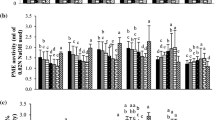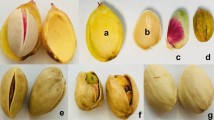Abstract
Peach palm has regions adjacent to the heart-of-palm that are normally neglected by the industry, and have potential to be utilized in minimally processed form. We characterized three parts of peach palm, evaluating anatomical, physicochemical and physiological parameters aiming to increase the industrial yield and evaluate shelf-life of the fresh-cut product. Harvested rods were sectioned into apical, median and basal segments, and analyzed for yield, firmness, soluble solids, titratable acidity, vitamin C, sugars and starch. Segments were sampled for anatomy and measurement of ethylene and respiration rates. After fresh-cut operations, segments were stored for 15 days at 5 °C and evaluated for surface color and carbohydrate content. The total yield based on length and fresh-mass was 85% and 70%, respectively. Hearts of palm were firmer toward the edges of apical and basal regions; the median region was the softest (14 N). The median region showed the highest SSC, 8.6 ºBrix and vitamin C, 9.4 mg ascorbic acid 100 g−1 FW, and maintained the highest ethylene production, either whole or sliced. Respiration rate of all regions decreased 1 h after segmentation, the apical region showed the highest rate, 364 mL CO2 kg−1 h−1, followed by median and basal. Yellowing and pronounced color difference occurred after two weeks of storage in all the studied regions. Partially differentiated vascular bundles were present in all regions. Based on firmness and chemical parameters, all regions have potential for use as minimally processed product and can be stored up to 7 days, maintaining the original color.









Similar content being viewed by others
References
C.R. Clement, J. Mora Urpí, Leaf morphology of the Pejibaye palm (Bactris gasipaes H.B.K.). Rev. Biol. Trop. 31, 103 (1983)
S. Graefe, D. Dufour, M. Van Zonneveld, F. Rodriguez, A. Gonzalez, Peach palm (Bactris gasipaes) in tropical Latin America: implications for biodiversity conservation, natural resource management and human nutrition. Biodivers. Conserv. (2013). https://doi.org/10.1007/s10531-012-0402-3
L.C. Anefalos, L.M.S. Tucci, V.A. Modolo, Uma visão sobre a pupunheira no contexto do mercado de palmito: análises e indicadores do agronegócio. Anál. Indic. Agronegócio 2, 7 (2007)
H Villachica (1996) Pijuayo (Bactris gasipaes H.B.K.). In: H Villachica (ed) Frutales y hortalizas promisorios de la Amazonia. TCA, Lima.
L.C. Sampaio, S.N.O. Neto, P.S.S. Leles, J.A. Silva, E.B. Villa, Análise técnica e econômica da produção de palmito de Pupunha (Bactris gasipaes Kunth) e de palmeira-real (Archontophoenix alexandrae Wendl. & Drude). Floresta Ambient. 14, 1 (2007)
L.M. Araújo, Aproveitamento industrial e caracterização físico-química de palmito de Pupunha (Bactris gasipaes H.B.K.). Masters Thesis, Instituto Nacional de Pesquisa da Amazonia, INPA, (1993)
C.R. Clement, R.M. Manshardt, C.G. Cavaletto, J DeFrank, J MoodJr, NY Nagai, K Fleming, F Zee (1996) Pejibaye heart-of-palm in Hawaii: from introduction to market. In: J Janick (ed) Progress in New Crops. American Society for Horticultural Science, Arlington, VA.
J. Mora-Urpí, J.C. Weber, C.R. Clement, Peach Palm (Bactris gasipaes Kunth): Promoting the Conservation and Use of Underutilized and Neglected Crops (International Plant Genetics Resources Institute, Rome, Italy, 1997)
DS Raupp, EA Staron, FCC Almeida, NS Onuki, FP Chaimsohn, AV Borsato (2004) Produção de farelo alimentar fibroso da parte caulinar do palmito Pupunha (Bactris gasipaes). UEPG Ci. Exatas Terra Ci. Agr. Eng. 6, 26. https://doi.org/10.5212/publicatio.v10i02.826.
H.M. Húngaro, V.O. Alvarenga, W.E.L. Peña, A.S. Sant'Ana, Hearts of palms preserves and botulism in Brazil: an overview of outbreaks, causes and risk management strategies. Trends Food Sci. Technol. (2013). https://doi.org/10.1016/j.tifs.2013.07.008
F.P. Chaimsohn, Cultivo de pupunha e produção de palmito (Editora UFV, Viçosa, Brazil, 2000)
Y.K. Hojeije, APPCC no plantio e na industrialização do palmito: Necessidade ou obrigação? Hig. Aliment. 20, 139 (2006)
G.P.C. Kalil, A.N. KalilFilho, L. Franciscon, Avaliação da qualidade do palmito in natura de duas populações de pupunha durante a vida de prateleira. Pesq. Flor. Bras. (2010). https://doi.org/10.4336/2010.pfb.30.63.261
C. Ghidelli, M.B. Pérez-Gago, Recent advances in modified atmosphere packaging and edible coatings to maintain quality of fresh-cut fruits and vegetables. Crit Rev Food Sci Nutr. (2018). https://doi.org/10.1080/10408398.2016.1211087
M.I. Gil, E. Aguayo, A.A. Kader, Quality changes and nutrient retention in fresh-cut versus whole fruits during storage. J. Agric. Food Chem. (2006). https://doi.org/10.1021/jf060303y
B. Yousuf, O.S. Qadri, A.K. Srivastava, Recent developments in shelf-life extension of fresh-cut fruits and vegetables by application of different edible coatings: A review. LWT (2018). https://doi.org/10.1016/j.lwt.2017.10.051
H. Luo, L. Jiang, L. Zhang, J. Jiang, Z. Yu, Quality changes of whole and fresh-cut Zizania latifolia during refrigerated (1 C) storage. Food and Bioprocess Tech. (2012). https://doi.org/10.1007/s11947-010-0459-5
B.B. Mishra, S. Gautam, A. Sharma, Browning of fresh-cut eggplant: Impact of cutting and storage. Postharvest Biol. Technol. (2012). https://doi.org/10.1016/j.postharvbio.2011.12.009
S. R. T. Valentini, Conservação de toletes de palmito Pupunha (Bactris gasipaes Kunth.) "in natura" sob refrigeração e atmosfera modificada. Doctorate Dissertation, 2010
R. Wills, B. McGlasson, D. Graham, D. Joyce, Postharvest: and Introduction to the Physiology and Handling of Fruit, Vegetables and Ornamentals, 4th edn. (CAB International, New York, 1998)
N. Iqbal, N.A. Khan, A. Ferrante, A. Trivellini, A. Francini, M.I.R. Khan, Ethylene role in plant growth, development and senescence: interaction with other phytohormones. Front in Plant Sci. (2017). https://doi.org/10.3389/fpls.2017.00475
B.C. Bolanho, E.D.G. Danesi, A.P. Beléia, Peach palm (Bactris gasipaes Kunth) Characterization and the potential of by-products flour processing. Food. Sci. Technol. Res. (2013). https://doi.org/10.3136/fstr.19.1061
J.M. Resende, O.J. Saggin Júnior, E.M.R. Silva, J.E. Flori, Palmito de pupunha in natura e em conserva (Brasília, DF, Embrapa Informação Tecnológica, 2009)
L.A.A. López, J.M.P. Vela, Manual práctico del cultivo de pijuayo para la producción de palmito en la zona del portal amazónico, Tarapoto (2010), https://www.iiap.org.pe/upload/publicacion/PUBL1215.pdf
M.C. Botelho, S.C. Leme, L.C.O. Lima, S.H. Abrahão, H.H. Silqueira, A.B. Chitarra, Qualidade de palmito pupunha minimamente processado: aplicação de antioxidantes. Ciênc. Agrotec. (2010). https://doi.org/10.1590/S1413-70542010000500033
Instituto Adolfo Lutz, Normas analíticas do Instituto Adolfo Lutz: Métodos físico-químicos para análise de alimentos, 4ed. Adolfo Lutz, São Paulo (2005), https://www.ial.sp.gov.br/ial/publicacoes/livros/metodos-fisico-quimicos-para-analise-de-alimentos
D.A. Johansen, Plant Microtechnique, 1st edn. (McGraw Hill Book Company Inc, New York, 1940)
T.O. O’Brien, N. Feder, M.E. McCully, Polychromatic staining of plant cell walls by toluidine blue. Protoplasma. (1964). https://doi.org/10.1007/BF01248568
R. Kasim, M.U. Kasim, Biochemical changes and color properties of fresh-cut green bean (Phaseolus vulgaris L cv gina) treated with calcium chloride during storage. Food Sci. Technol. (2015). https://doi.org/10.1590/1678-457X.6523
M. Dubois, K.A. Gilles, J.K. Hamilton, P.A. Rebers, F. Smith, Colorimetric method for determination of sugars and related substances. Anal. Chem. (1956). https://doi.org/10.1021/ac60111a017
N. Nelson, A photometric adaptation of Somogyi method for determination of glucose. Biol. Chem. 153, 375 (1944)
R.M. McCready, J. Guggolz, V. Silviera, H.S. Owens, Determination of starch and amylase in vegetables. Anal. Chem. (1950). https://doi.org/10.1021/ac60045a016
A.M. Mapeli, F.L. Finger, J.G. Barbosa, R.S. Barros, L.S. Oliveira, F.B. Segatto, Influence of storage temperature on Epidendrum ibaguense flowers. Acta Sci. Agron. (2011). https://doi.org/10.4025/actasciagron.v33i1.6365
D.F. Ferreira, Sisvar: a guide for its bootstrap procedures in multiple comparisons. Ciênc. Agrotec. (2014). https://doi.org/10.1590/S1413-70542014000200001
A.J. RodriguesNeto, A.F. Bergamaschine, O.J. Isepon, J.B. Alves, F.B.T. Hernandez, M.P. Macedo, Efeito de Aditivos no Valor Nutritivo de Silagens feitas com Subproduto da Extração do Palmito de Pupunha (Bactris gasipaes H.B.K.). Rev. Bras. Zootec. (2001). https://doi.org/10.1590/S1516-35982001000500033
A.G. Soares, Palmito de pupunha – alternativas de processamento. Hortic. Bras. 15, 198 (1997)
T.M. Magellan, P.B. Tomlinson, B.A. Huggett, Stem anatomy in the spiny American palm Bactris (Arecaceae-Bactridinae). Hoehnea. (2015). https://doi.org/10.1590/2236-8906-18/2015
P.B. Tomlinson, Anatomy of the monocotyledons. II. Palmae (Clarendon Press, Oxford, 1961)
R.A. Pereira, K.E. Quadros, Comparação anatômica de palmitos em conserva de Archontophoenix alexandrae (F. Mueller) H. Wendl. et Drude e Bactris gasipaes H.B.K. (Arecaceae). Rev. Bras. Bioci. 5, 100 (2007)
C.R. Clement, L.A. Santos, J.S. Andrade, Conservação de palmito de Pupunha em atmosfera modificada. ACTA Amazon. (1999). https://doi.org/10.1590/1809-43921999293445
M.C. Arruda, A.P. Jacomino, R.A. Kluge, M. Azzolini, Temperatura de armazenamento e tipo de corte para melão minimamente processado. Rev. Bras. Frutic. (2003). https://doi.org/10.1590/S0100-29452003000100022
D. Zagory, Effects of post-processing handling and packaging on microbial populations. Postharvest Biol. Technol. (1999). https://doi.org/10.1016/S0925-5214(98)00093-3
M.A.M. Monteiro, P.C. Stringheta, D.T. Coelho, J.B.R. Monteiro, Estudo químico de alimentos formulados à base de palmito Bactris gasipaes HBK (pupunha) desidratado. Ciência Tecnol. Alim. (2002). https://doi.org/10.1590/S0101-20612002000300002
A.A. Kader, Postharvest technology of horticultural crops, 3rd edn. (Oakland, ANRCS, 2002)
M Cantwell, TV Suslow (2002) Postharvest handling systems: Fresh-cut fruits and vegetables. In AA Kader (ed) Postharvest technology of horticultural crops. University of California, Division of Agriculture and Natural Resources, Oakland.
J. Guo, S. Wang, X. Yu, R. Dong, Y. Li, X. Mei, Y. Shen, Polyamines regulate strawberry fruit ripening by abscisic acid, auxin, and ethylene. Plant Physiol. (2018). https://doi.org/10.1104/pp.18.00245
R. Zhai, J. Liu, F. Liu, Y. Zhao, L. Liu, C. Fang, H. Wang, X. Li, Z. Wang, F. Ma, L. Xu, Melatonin limited ethylene production, softening and reduced physiology disorder in pear (Pyrus communis L.) fruit during senescence. Postharvest Biol. Technol. (2018). https://doi.org/10.1016/j.postharvbio.2018.01.017
T. Boller, H. Kende, Regulation of wound ethylene synthesis in plants. Nature (1980). https://doi.org/10.1038/286259a0
S. Shiomi, M. Yamamoto, T. Ono, K. Kakiuchi, J. Nakamoto, A. Nakatsuka, Y. Kubo, R. Nakamura, A. Inaba, H. Imaseki, cDNA cloning of ACC synthase and ACC oxidase genes in cucumber fruit and their differential expression by wounding and auxin. J. Jpn. Soc. Hort. Sci. (1998). https://doi.org/10.2503/jjshs.67.685
M. Tatsuki, H. Mori, Rapid and transient expression of 1-aminocyclopropane-1-carboxylate synthase isogenes by touch and wound stimuli in tomato. Plant Cell Physiol. (1999). https://doi.org/10.1093/oxfordjournals.pcp.a029597
A.E. Watada, K. Abe, N. Yamuchi, Physiological activities of partially processed fruits and vegetables. Food Technol. 44, 116 (1990)
S. Sakr, M. Noubahni, A. Bourbouloux, J. Riesmeier, W.B. Frommer, N. Sauer, S. Delrot, Cutting, ageing and expression of plant membrane transporters. Biochim. Biophis. Acta. (1997). https://doi.org/10.1016/S0005-2736(97)00169-7
E. Katz, J. Riov, D. Weiss, E.E. Goldschmidt, The climacteric-like behaviour of young, mature and wounded citrus leaves. J. Exp. Bot. (2005). https://doi.org/10.1093/jxb/eri137
Author information
Authors and Affiliations
Corresponding author
Additional information
Publisher's Note
Springer Nature remains neutral with regard to jurisdictional claims in published maps and institutional affiliations.
Rights and permissions
About this article
Cite this article
Fonseca, K.S., Melo, A.A.M., da Rosa Ferraz Jardim, A.M. et al. Physicochemical, physiological and anatomical properties of three segments of peach palm for industrial use and minimal processing. Food Measure 13, 2871–2886 (2019). https://doi.org/10.1007/s11694-019-00208-2
Received:
Accepted:
Published:
Issue Date:
DOI: https://doi.org/10.1007/s11694-019-00208-2




